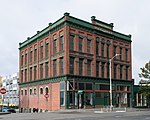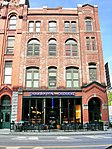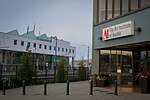Lundeberg Derby Monument

The Lundeberg Derby Monument, on First and Wall Street , is a part of a series of works in Seattle, Washington created to improve First Street in 1987 called the First Avenue Project. The statue was installed by Buster Simpson when the building behind it, the El Gaucho Inn, was still owned and occupied by the Sailor's union. The statue is dedicated to Harry Lundeberg, a key figure in the Sailor's Union Strike of 1886. Lundeberg created the sub/Union cap that was later known as the "Lundeberg Stetson".The statue's pillars stand roughly three feet high, atop the northernmost pillar is a derby cap, worn by members of the Sailors Union. The pillars were salvaged by Jack Mackie and Buster Simpson from a quarry just before it went bankrupt, the two of the artists involved in First Avenue Project.
Excerpt from the Wikipedia article Lundeberg Derby Monument (License: CC BY-SA 3.0, Authors, Images).Lundeberg Derby Monument
1st Avenue, Seattle Belltown
Geographical coordinates (GPS) Address Nearby Places Show on map
Geographical coordinates (GPS)
| Latitude | Longitude |
|---|---|
| N 47.6147 ° | E -122.3489 ° |
Address
1st Avenue 2501
98121 Seattle, Belltown
Washington, United States
Open on Google Maps









